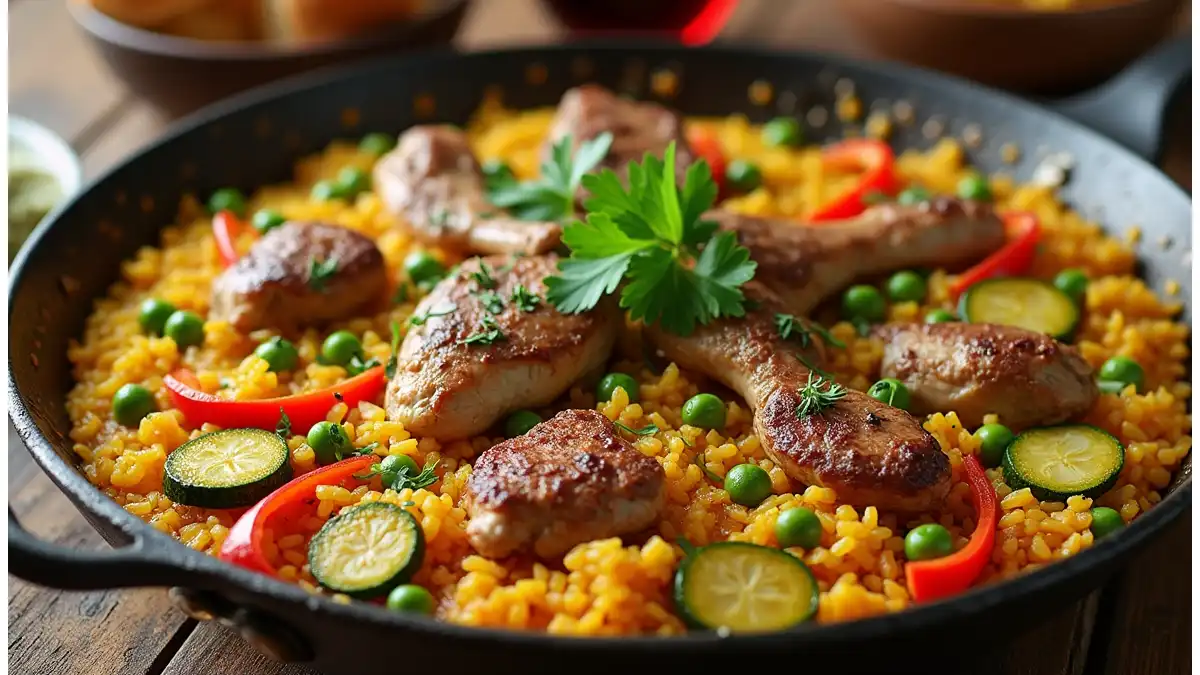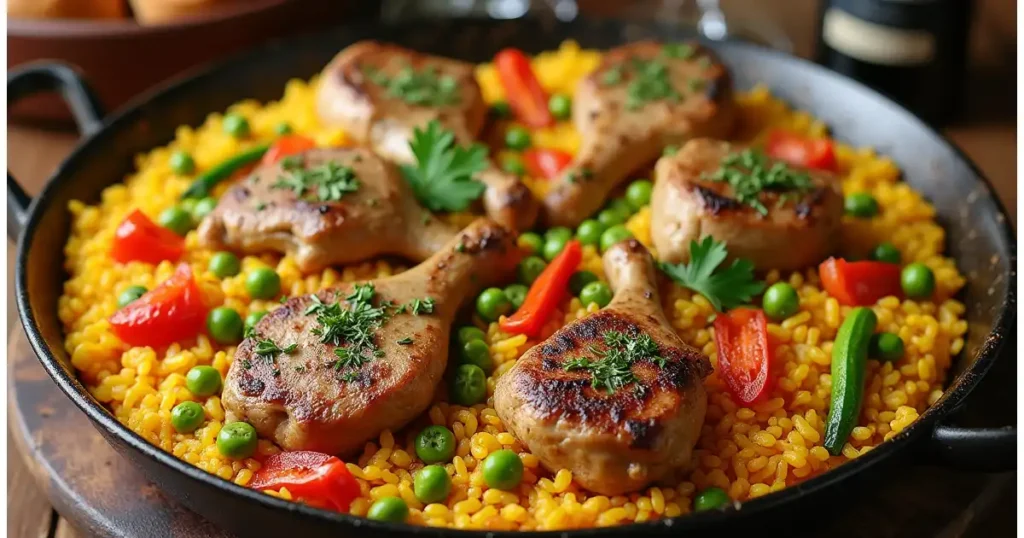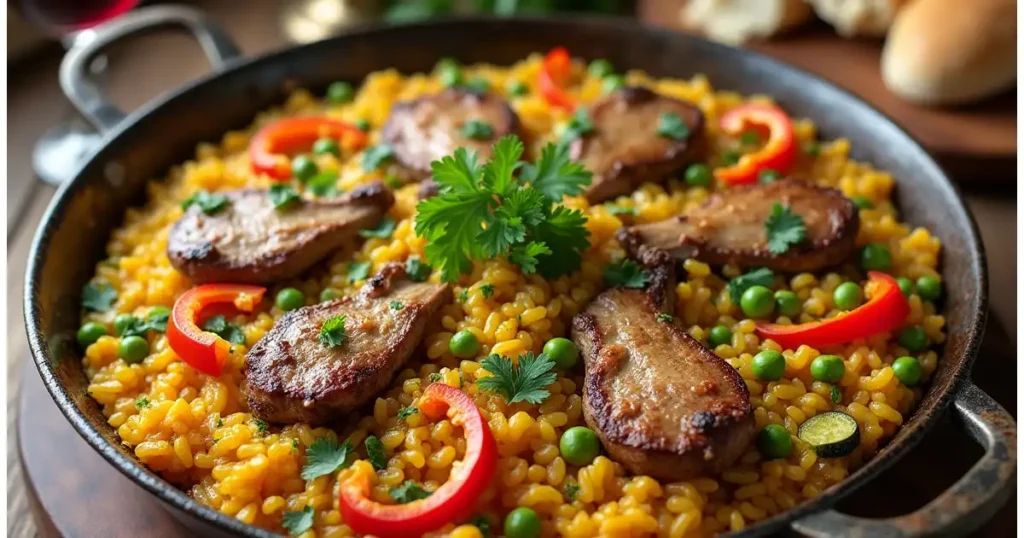
Table of Contents
Introduction
Paella, one of Spain’s most iconic dishes, hails from the Valencia region.
Traditionally made with a variety of proteins like seafood, chicken, and rabbit, this version features a delicious combination of chicken and lamb, creating a hearty and flavorful dish.
What makes this chicken and lamb paella special is the balance of tender, juicy meats, aromatic spices, and perfectly cooked rice, infused with saffron for that signature golden color. Whether you’re making it for a family dinner or a special occasion, this dish is sure to impress!
Ingredients for Chicken and Lamb Paella
To make the perfect paella, you’ll need the following ingredients:
- 250 g of rice – Preferably short-grain rice like Bomba or Arborio
- 350 g of chicken, cut into bite-sized pieces
- 6 lamb chops – Adds a rich, deep flavor
- 50 g of shelled peas – Provides sweetness and freshness
- 100 g of zucchini, quartered – Adds texture
- 100 g of shelled fava beans – A traditional Spanish ingredient
- 1 roasted red bell pepper, peeled and sliced – Brings smokiness and color
- 1 onion, finely chopped – Essential for depth of flavor
- 2 cloves of garlic, minced – A must-have for aroma
- 1 tbsp tomato paste – Enhances richness
- 10 cl olive oil – For frying and flavor
- 2 pinches of saffron threads – The heart of paella’s signature flavor
- 1 bunch of coriander – For freshness
- 4 sprigs of fresh thyme – Adds an earthy taste
- 85 cl chicken or vegetable broth – For cooking the rice
- Salt and pepper to taste

Step-by-Step Instructions
1. Searing the Meat for Maximum Flavor
Warm olive oil in a paela pan over medium heat.
Add the chicken pieces and lamb chops and sear until golden brown on all sides. This step locks in the juices and creates a rich, flavorful base. Once done, remove the meat and set it aside.
2. Cooking the Aromatics
In the same oil, sauté onions and garlic until they become soft and fragrant. This helps create a deeply flavorful base that will infuse into the rice.
3. Toasting the Rice for Authentic Texture
Add the rice to the pan and stir until it becomes slightly translucent. This process coats the rice with oil and enhances its ability to absorb flavors.
4. Adding the Broth and Seasoning
Pour in the broth, then stir in the tomato paste, saffron, thyme, coriander, salt, and pepper. Bring everything to a boil.
5. Arranging the Meat and Vegetables
Reduce the heat and carefully arrange the chicken, lamb, and vegetables (peas, zucchini, fava beans, and roasted red pepper) on top of the rice. This ensures that everything cooks evenly while infusing the rice with the flavors of the meat and veggies.
6. Simmering to Perfection
Cover the pan with aluminum foil and let it simmer gently until the rice is fully cooked and has absorbed all the liquid. Be patient—this step is key to achieving the perfect paella texture.
7. Resting and Serving
Turn off the heat and let the paella rest for 5 minutes before serving. This helps the flavors meld, enhancing the dish’s taste even further. Serve hot and enjoy!
Tips and Tricks for the Perfect Paella
- Use the right rice – Short-grain rice absorbs flavors without becoming mushy.
- Don’t stir too much – Unlike risotto, paella should be left undisturbed to develop a slightly crispy bottom layer (the famous “socarrat”).
- Cook on low heat – This allows all the flavors to meld together.
- Adjust seasoning – Taste and adjust salt and spices as needed.

Serving Suggestions and Pairings
Pair your chicken and lamb paella with:
- A glass of Spanish red wine like Rioja
- A fresh green salad
- Some crusty bread to soak up the sauce
- A side of garlic aioli for dipping
Paella, one of Spain's most celebrated culinary treasures, has a storied history rooted in the fertile lands of Valencia. Traditionally prepared with ingredients like rabbit, chicken, and snails—staples of rural life in the region—this dish evolved into countless variations as it spread across the country and beyond. Among these adaptations, the Chicken and Lamb Paella stands out as a harmonious blend of tradition and innovation, offering a unique twist that delights modern palates while honoring its humble origins.
From Farm to Feast: The Origins of Paella
The story of paella begins in the fields surrounding Valencia, where farmers and laborers crafted this hearty dish over open flames using what they had on hand: rice, fresh vegetables, and locally sourced proteins such as chicken and rabbit. Over time, paella became more than just sustenance—it transformed into a symbol of community and celebration, often prepared for gatherings and festivals. As trade routes expanded and new ingredients were introduced, cooks began experimenting with additions like seafood, beans, and spices, giving rise to the diverse array of paellas enjoyed today.
Lamb, though not traditionally part of the classic Valencian recipe, holds deep cultural significance in other parts of Spain, particularly in regions known for their sheep farming. By incorporating lamb into paella, chefs created a bridge between the agrarian roots of the dish and the pastoral traditions of Spain’s interior. This fusion results in a rich, flavorful experience that pays homage to both coastal and inland influences.
Why Chicken and Lamb Make the Perfect Pair
What sets the Chicken and Lamb Paella apart is the seamless marriage of two distinct yet complementary meats. Chicken brings tenderness and juiciness, providing a lighter contrast to the bold, earthy flavors of lamb. Together, they create layers of complexity that elevate the dish from simple comfort food to an unforgettable feast. The combination also reflects the adaptability of paella, proving that this versatile dish can accommodate regional preferences without losing its soul.
To enhance the richness of the meats, aromatic spices like saffron, garlic, and thyme are added, infusing the rice with a golden hue and a depth of flavor that lingers long after the meal is finished. Fresh herbs like coriander add brightness, while seasonal vegetables such as zucchini, peas, and roasted red peppers bring color, texture, and sweetness to the plate.
Bringing Tradition to Your Table
Preparing Chicken and Lamb Paella at home allows you to connect with centuries of culinary heritage while putting your own spin on the dish. Here are some tips to ensure success:
- Use short-grain rice varieties like Bomba or Calasparra, which absorb liquid beautifully without becoming mushy.
- Don’t be afraid to let the rice develop a crispy bottom layer, known as socarrat. This caramelized crust is considered the crowning glory of any well-made paella.
- Cook slowly and patiently, allowing the flavors to meld together and the rice to cook evenly.
- Finish with a squeeze of lemon juice or a sprinkle of fresh parsley for a burst of freshness.
A Dish Worth Celebrating
Whether you’re hosting a family dinner or celebrating a special occasion, **Chicken and Lamb Paella** is sure to impress. Its vibrant colors, tantalizing aromas, and satisfying flavors make it a standout choice for any gathering. Pair it with a crisp Spanish white wine or a robust Rioja, and serve alongside a simple green salad or crusty bread for soaking up every last drop of the flavorful broth.
In essence, this dish is more than just a meal it’s a journey through Spain’s rich gastronomic history, brought to life in each bite. So gather your loved ones, fire up the paella pan, and savor the magic of Chicken and Lamb Paella, where tradition meets innovation in perfect harmony.
Conclusion
Paella is more than just a meal; it’s a celebration of flavors and tradition. This chicken and lamb paella brings together the richness of the meats, the sweetness of vegetables, and the aromatic touch of saffron. Whether you’re cooking for a gathering or just treating yourself, this dish is sure to be a showstopper.
FAQs
1. What is the secret ingredient in paella?
The secret ingredient in paella is saffron , which gives the dish its distinctive yellow color and a subtle, earthy flavor. Some chefs also consider the technique of cooking over an open flame and using high-quality ingredients as part of the “secret.”
2. What can you not put in paella?
Traditionalists argue that rice should be the star of paella, so heavy sauces (like tomato sauce) or creamy elements should be avoided. Also, some purists avoid mixing seafood and meat in the same dish, though this is more common in modern interpretations.
3. What is the secret to a good paella?
- The secret to a good paella lies in:
- Using high-quality rice (typically Bomba or Calasparra rice).
- Cooking the rice in a wide, shallow pan to achieve the perfect texture.
- Achieving the socarrat (crispy bottom layer of rice).
- Letting the flavors meld by allowing the paella to rest for a few minutes before serving.
4. What are the three types of paella?
- The three main types of paella are:
- Valencian Paella : The original version, featuring chicken, rabbit, beans, and snails (optional).
- Seafood Paella : Made with various types of seafood like shrimp, mussels, clams, and squid.
- Mixed Paella (Paella Mixta) : A combination of both meat and seafood.
5. What is the most important spice in paella?
The most important spice in paella is saffron , which provides the signature golden hue and a unique aroma. If saffron is unavailable, some cooks use turmeric or paprika as substitutes, but these don’t replicate the authentic taste.
6. Why are there no onions in paella?
Traditional Valencian paella does not include onions because they can overpower the delicate flavors of the other ingredients. However, onions are often used in variations like seafood or mixed paella to enhance flavor. Purists stick to garlic and bell peppers instead.
7. What can I add to paella for more flavor?
- To enhance the flavor of paella, you can add:
- Fresh herbs like rosemary or thyme.
- Lemon juice or zest for brightness.
- Smoked paprika for depth.
- Chorizo or diced ham for richness.
- Artichokes or peas for extra texture.
8. What does the chef put in his paella?
- Chefs typically use fresh, seasonal ingredients such as:
- High-quality rice.
- Aromatic spices (saffron, paprika, garlic).
- Fresh seafood, poultry, or vegetables.
- Homemade stock (fish, chicken, or vegetable) for added depth.
- Olive oil for frying and enhancing flavors.
9. What are the crispy bits in paella?
The crispy bits at the bottom of the paella are called socarrat . This caramelized layer forms when the rice is cooked slowly over medium heat, creating a crunchy, flavorful crust that many consider the best part of the dish.
10. What ingredient makes paella yellow?
The ingredient that gives paella its yellow color is saffron . In some cases, turmeric or annatto seeds may also be used to achieve a similar hue, but saffron remains the traditional choice for both color and flavor.
Choose what you like from the dinner menu to end your day happily